Think search marketing is the hottest thing around? Think again. Only 84% of the US Internet-using population uses search engines on a regular basis. However, 92.5% use email.
Email is big business. All the major online providers sell ads against eyeballs in their email systems, and most offer paid subscriptions for premium service.
We wondered which domains really rule the roost for personal use, so we worked with email service provider aWeber to gather exclusive year-over-year data for you.
Top 10 "personal" email address domains: 2004-2005MarketingSherpa's Research Director Stefan Tornquist notes, "The relationship between domains and the total populations has remained virtually unchanged. In 2004 the top 100 domains represented 77.3% of the total, and in 2005 the percentage has grown to only 77.6%."
In other words, although consumers change their personal email addresses at a rate of roughly 20% per year (MarketingSherpa estimate) year-over-year marketshare between the big guys remains fairly stagnant.
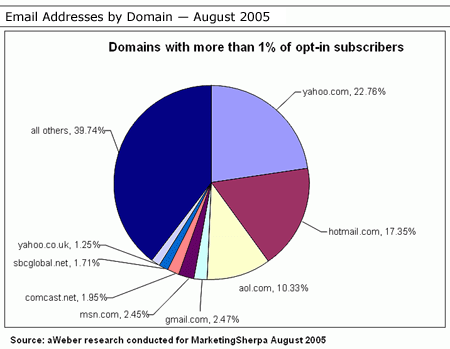
We strongly suspect a huge portion of the 39.74% "all others" slice is at-work addresses.
By "personal," we mean the address a consumer uses when he or she opts-in to receive email for personal use from a trusted source. So this 39.74% indicates a vast swathe of consumers prefer to use their at-work email address for personal use and are viewing personal email at work.
Since at-work deliverability is roughly 100% worse than at-home delivery (due to corporate spam filters) this means B-to-C mailers need to run campaign creative against popular corporate filters before sending. It's not enough to be whitelisted at AOL anymore.
Plus, it means since Microsoft Outlook dominates at-work email client use, Outlook settings and design considerations must be considered for B-to-C email campaigns.
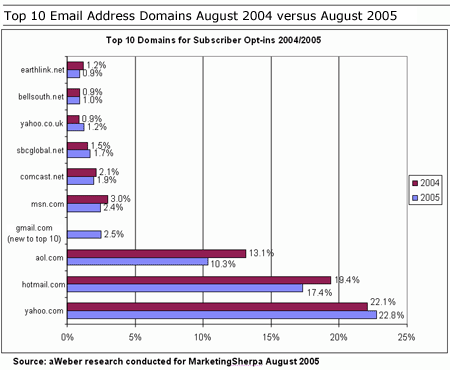
Of this chart, Tornquist notes, "The remarkable marketplace stability, given the rapid rise of Gmail into the top 10, indicates that their growth has been at the expense of others from the top 100 domains." In other words, Steve Ballmer has another reason to snarl when he hears the name Google.
That said, 2.5% is fairly pitiful when you consider how long Gmail has been around. Google obviously hasn't put much energy behind its promotion -- they've decided other fish are more worth frying. And perhaps email filtering and management turned out to be far more difficult than their engineers initially thought. (In our experience, everything about email sending, receiving and design is always far harder than it appears at first glance.)
Three more notes:
o AOL suffers the largest loss on this chart -- slipping 2.8 marketshare points.
o Microsoft isn't far behind, with a total 2.6% loss when you combine MSN mail and Hotmail losses. That said, we have no data on Outlook gains/losses.
o Yahoo is one of the few winners with a .7% gain in the US and .3% gain from UK addresses signing up for lists mainly owned by US mailers. See below for Yahoo's other gains overseas.
Year's biggest losses -- nostalgia centralYour reaction to this next chart will reveal whether you're over 35 or not. There was a day when names like Compuserve, Prodigy and Mindspring were major email players. That day has clearly passed.
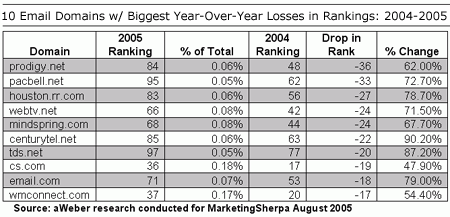 Year's biggest gains in ranking and top 10 international domains on US-owned lists
Year's biggest gains in ranking and top 10 international domains on US-owned listsHere you can see that Hotmail is making serious strides overseas, even if it's losing ground at home. At .64% of total names on US owners' lists, Hotmail.co.uk is still smaller than Yahoo.co.uk.
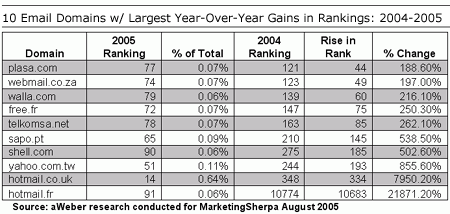
Yahoo dominates this chart with four of the top 10 spaces.
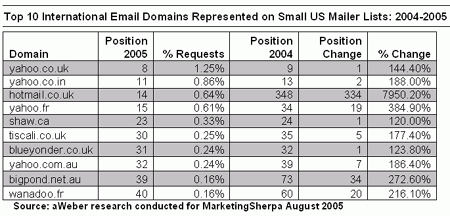 More action items for marketers -- how should you react?
More action items for marketers -- how should you react?We've said this a hundred times, but it's worth saying again: If you don't have a Yahoo test email account, get one. While you're at it, get one for the rest of the US Top 10 as well, in addition to several versions of Microsoft Outlook. You need to know how your email looks in each system, as well as whether it's delivered.
In addition, Internet advertisers who want to reach beyond search for broad reach campaigns should consider testing campaigns on the monitor space surrounding email access for the biggies such as Yahoo, Hotmail, etc.
One concern of the past was "if a consumer is engrossed in personal email, how likely is it that they'll click on a banner ad or even notice one?" We've heard firsthand from several B-to-C advertisers in ecommerce, brand marketing and the nonprofit/charitable giving spaces that their test campaigns placing ads in the free email viewing environment can work.
Their anecdotal evidence suggests ads placed carefully at both the beginning and end of the email experience work best. So you catch consumers as they walk in the door and back out again.
About the source of data for these chartsThis data was based on domain names for 784,000 confirmed (double) opt-in names on aWeber's files for August 2004 versus the 1,600,000 confirmed names on their file as of August 2005. The more than double growth in total names was due to an increase in clients and a year-over-year growth in deliverable names per client list.
Obviously data based on one loan ESP's client lists is somewhat suspect for comprehensiveness. If you surveyed another ESP's database, the numbers would probably be slightly different depending on their client base. So, why do we feel these stats are significant?
Because aWeber's client file is slightly unusual.
Headquartered in Pennsylvania, aWeber Communications has been an email service provider since 1998. Instead of the big email players, their clients are thousands of small business owners -- many with only a handful of employees -- ranging from hometown golf clubs to local physicians' offices.
With an average of 6,000 names each, these clients' lists are incredibly tiny compared to the name-brand emailers of this world. But, 98% are confirmed opt-in (i.e., double opt-in), which is a far tougher standard than most major B-to-C list owners stick to. Plus, many of these list owners have a one-to-one relationship with the names on their list in real life. (In other words, they've actually met the person who signed up.)
These facts indicate to us that the consumers on these lists are highly likely to have given their primary email address when they signed up. They are truly ready, willing and want to be able to get email from these mailers. It's not about an online sweeps entry form you may slam your spare freebie email address into; it's about finding out what new videos are out this week at the rental place down the street.
That's why when it comes to email accounts consumers actively use for personal news, we believe the above charts represent an unusually true portrait of domain marketshare.
Useful links related to this articleMarketingSherpa's 2004 Update: The State of the Free Email Industry - Action Points for Marketers:
http://www.marketingsherpa.com/article.html?id=23701
aWeber Communications: http://www.aweber.com













